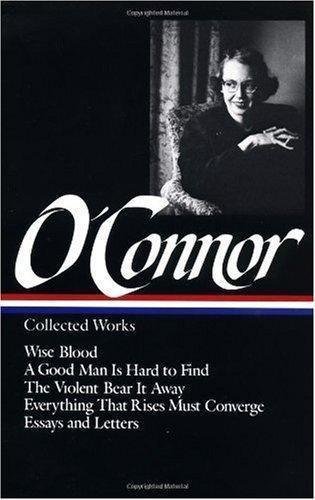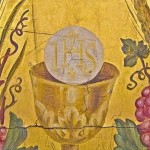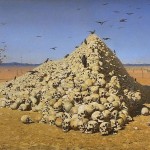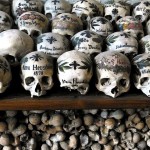One of the main problems with current debates about the state of Catholic literature is the lack of a consensus about what makes literature Catholic.
Paul Elie sets up one set of criteria that can only presumably be met by the novel he’s now writing. Randy Boyagoda argues contemporary Catholic literature doesn’t interface with the experience of its readers, but he promises us a book that will do just that.
Gregory Wolfe of IMAGE Journal makes an argument is more nuanced and distanced. He argues that the tone of Catholic literature has changed from the shouting of Flannery O’Connor to a more subtle whisper.
For those of you who don’t remember, O’Connor said the following in one of her letters (collected here):
“The novelist with Christian concerns will find in modern life distortions which are repugnant to him, and his problem will be to make these appear as distortions to an audience which is used to seeing them as natural; and he may well be forced to take ever more violent means to get his vision across to this hostile audience. When you can assume that your audience holds the same beliefs you do, you can relax a little and use more normal ways of talking to it; when you have to assume that it does not, then you have to make your vision apparent by shock — to the hard of hearing you shout, and for the almost blind you draw large and startling figures” (Collected Works, 805-806).

I won’t rub everyone’s noses in the uncomfortable fact that her shouting was followed by one of the great demographic collapses in American Catholic history. Maybe her methods, despite the good intentions, were not as effective as we’d like to remember” As for the state of Catholic literature these days, Wolfe shifts the blame from the writers to the readers and their conventional reading habits:
“So here’s my counter-thesis: The loss of a Catholic presence in mainstream literary culture is not because we are suffering from a dearth of gifted Catholic writers but because ideological blinders have prevented religious and secular people alike from perceiving and engaging the work that is out there.
In other words, we suffer from a type of spiritual and cultural anorexia: What would feed and nourish us is before us, but we will not eat.”
In his The Fine Delight: Postconciliar Catholic Literature Nick Ripatrazone adds even more complexity to the task of identifying what might count as Catholic literature:
“Catholic literature, and Catholic writers, resist definition. To be ‘catholic’ is to be inclusive to accept all voices, though not all writing can be considered religiously Catholic. Is a writer Catholic because of her standing within the Church: baptized, confirmed, practicing? What if she is inactive or lapsed? Is she only Catholic if she operates in fidelity with the doctrinal beliefs of the Church; are certain beliefs more important than others? Would a staunchly pro-life writer not be considered Catholic if she rejected papal infallibility? What about writers who convert to, or from the faith? Or a writer living ‘culturally’ as a Catholic, but not participating in the rituals of the Church? Which is more important: biography or literary content? If an atheist writes a novel about a priest, is that novel Catholic, or is it only Catholic if the characters act in accordance with Church teachings, and do not leave the seminary for the secular world? When the Vatican issued a letter condemning Graham Greene’s 1940 novel, The Power and the Glory, Greene penned a sly response to Cardinal Pizzardo in April 1954, reinforcing his allegiance to the Church. Does it make Greene any less Catholic of a writer if he elsewhere admitted to not simply adultery, but a long-term extramarital relationship? There might be no end to Catholic forgiveness, but what of literary absolution?”

Ripatrazone’s book features well-known Catholic whisperers such as Ron Hansen, Andre Dubus, and Paul Mariani.
The Fine Delight (there’s also a website) includes a chapter that profiles a whole host of other Catholics, practicing, lapsed, cultural, and even non-Catholics who’ve written in a Catholic vein. You can find some of them on my lists of living religious poets and novelists.
Ripatrazone also makes the past even messier than I suggested above by pointing out the obvious: how Walker Percy wrote mostly about ambivalent Episcopalians, whereas Flannery mostly about lapsed Baptists. What’s more, he suggest they adopted these strategies to counter a tidal wave of (if I may borrow a judgment Gombrowicz passed on Sienkiewicz) first-rate second-rate Catholic writers:
“This Catholic intellectual sense might have found its origins in a reaction against the inevitable proliferation of dogmatic Catholic literature a near subculture of ‘literary production including presses, publishers, newspapers, book clubs, awards, conferences, and professional associations.'”
When thinking about the past we tend to think of a lost paradise. For example, when thinking about the 60’s we think of Bob Dylan, The Beatles, The Rolling Stones, and Floyd. We not only forget about their failed albums, but also all the dross they were competing with for airtime. What else was playing? I don’t know. And I’m glad for it, but I know it’s there should I want to do the research.
If the critics want to avoid shouting at each other instead of making balanced judgments, then they have to figure out the criteria of literature, Catholic… My own predilection for messiness and surprise inclines me toward Wolfe and Ripatrazone.
If you want to familiarize yourself with some of the debates then see: Elie’s Tumblr site, Ripatrazone’s blogspot blog, Dana Gioia’s First Things essay, and Wolfe’s website. As you can see, there isn’t even a consensus about what internet platforms to use!
The short answer to the title question? For now we have no idea.











